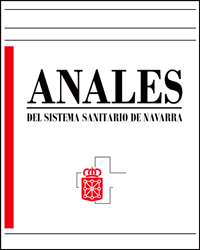Treatment of ascites in cirrhotic patients
DOI:
https://doi.org/10.23938/ASSN.0402Keywords:
Ascitis. Cirrosis.Abstract
Ascites is the most frequent complication of hepatic cirrhosis and its appearance brings a reduction of survival. The treatment aims to mobilise the intraperitoneal liquid and to prevent its reaccumulation. The first step of treatment includes rest in bed, a hyposodic and spironolactone diet, alone or in combination with furosemide or torasemide. However, 10-20% of patients do not respond to treatment or develop adverse effects that limit its use, which is termed refractory ascites. These patients must be considered as possible candidates for a liver transplant and, when this is not possible, the chosen treatment is total paracentesis with an intravenous infusion of albumin. In patients who do not tolerate paracentesis, or who require its realisation with great frequency, other therapeutic options can be evaluated, such as surgical anastomoses, intrahepatic portosystemic percutaneous derivation and, in the final instance, peritoneo-venous shunt.Downloads
Downloads
Published
How to Cite
Issue
Section
License
La revista Anales del Sistema Sanitario de Navarra es publicada por el Departamento de Salud del Gobierno de Navarra (España), quien conserva los derechos patrimoniales (copyright ) sobre el artículo publicado y favorece y permite la difusión del mismo bajo licencia Creative Commons Reconocimiento-CompartirIgual 4.0 Internacional (CC BY-SA 4.0). Esta licencia permite copiar, usar, difundir, transmitir y exponer públicamente el artículo, siempre que siempre que se cite la autoría y la publicación inicial en Anales del Sistema Sanitario de Navarra, y se distinga la existencia de esta licencia de uso.








